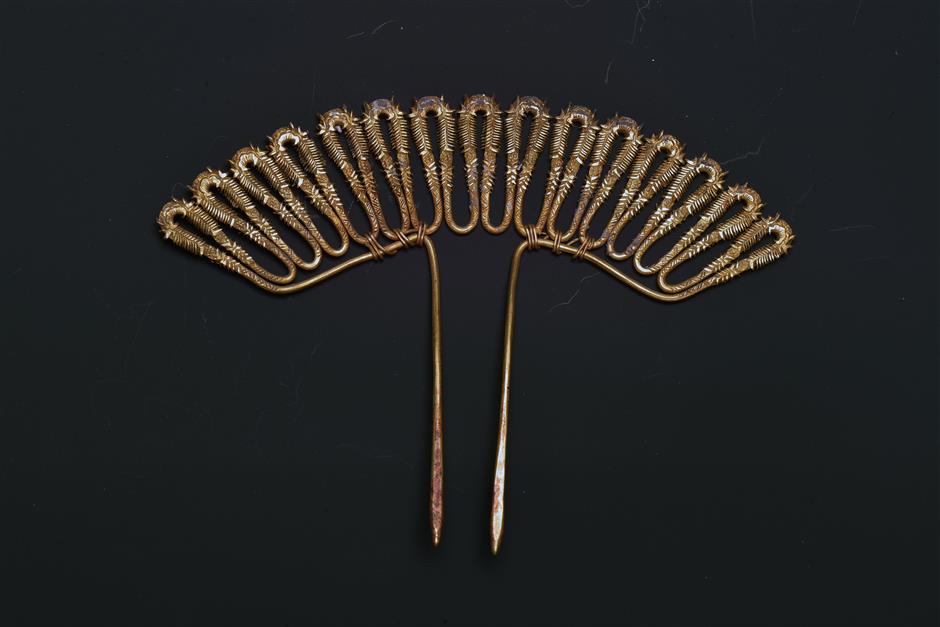A bird's-eye view of China's ancient capital
During the Southern Song Dynasty (1127-1279), the present-day city of Hangzhou was made the capital of China and named Lin'an. Local authorities started to excavate and comb through the capital's relics in 1983 and gradually the layout of the ancient city was brought to light after being buried underground for centuries.
An ongoing exhibition at Hangzhou Museum presents the capital, Lin'an, to visitors through myriad antiques and replicated models. More than 1,000 sets of artworks on loan from museums across the country concerning the pinnacle of ancient aesthetics are on display, including 13 top-flight national treasures.
The provincial government initiated the Song Dynasty Cultural Legacy Project in August 2021, aiming to build Song Dynasty culture into a paramount icon of Zhejiang Province, with elements to distinguish the Song from other dynasties for its booming economy and invigorating art.
The revival of imperial palaces, city walls and seawalls is one of the project's highlights. Since these relics cannot be moved to museums, organizers use three-dimensional models to capture the cityscape of that period.
Top-notch treasures, including an oval fan painting, gold accessories and silver vessels, give people a glimpse into the dynasty's thriving art scene.
The importance of hand-held fans for the male literati in ancient China was akin to hairpins for women. Artists would write calligraphy and paint on the fans to display their aspirations and sentiments.
One oval fan on loan from Suzhou Museum depicts the roaring Qiantang River tidal bores, undulating riverside hills and the Liuhe Pagoda. Liuhe means "six harmonies" in Chinese philosophy.

An oval fan painting
Qiantang tide watching has been a popular activity for centuries, dating back to the Han Dynasty (206 BC-AD 220). By the Southern Song Dynasty, it had become a well-established event on the social calendar for both ordinary people and the royal court.
The river has the world's largest tidal bores that attract visitors from near and far, and are best viewed in October when at their peak.
Usually, a Chinese fan painting includes calligraphy, an ink drawing and a Chinese seal, which bears the name of the painter. However, as the ink fades over the years, art experts today can no longer tell who painted the oval fan from Suzhou.
During the Southern Song Dynasty, silver ingots developed further in terms of trade and finance. They were used among both nobles and common folk in exchange for tea, silk, salt and other goods.
This dynasty witnessed an increase in the variety of ingots in circulation. The exhibited silver ingots, for example, were minted by prefecture-level authorities who would then hand them over to the imperial court.
Metallurgy boomed during that period, and the archaeological record indicates ritual use of metal vessels.
The exhibition displays a pair of silver shoes unearthed from a mausoleum in the city of Dongyang in central Zhejiang Province. The patterned shoes reflected the owner's social status and wealth.
Gold and silver were also highly valued by craftsmen due to their high economic value and malleability.
Gold was more popular than in previous dynasties, because the Song royal court permitted private mining and free trade. The once-unattainable gold finally became available to common people.
Hairpins were the most sought-after item among women.
Southern Song-style accessories featured smoother lines, thinner textures and minimalist designs.

A gold hairpin shaped like a peacock tail
The exhibition displays a hairpin shaped like a peacock tail, which still looks chic by modern-day aesthetics. It was unearthed from a Southern Song tomb in Zhejiang in 2009.
According to archival information, Hangzhou had many workshops in the Southern Song Dynasty, and the competition among craftsmen was fierce, forcing them to create boutiques, new techniques and varieties.
The development of welding techniques produced a specific pattern called manchijiao that had lotus, mandarin ducks and sagittaria in a pond. The pattern was common in the daily utensils, which can be seen in some of the exhibits on display.
On weekends interactive activities will be held, with a dozen time-honored crafts for kids to have an immersive exhibition experience.
City archives reveal the stores selling a wide range of products, from scissors and fans to woodblock printed books and embroidery were once all over the city.
The museum has selected a dozen of these items thought to typify the prosperity of Hangzhou in the Southern Song era.

A gold cup patterned with manchijiao
The Ancient Capital Lin'an Exhibition
Date: Through January 3, 2023 (closed on Mondays), 9am-4:30pm
Venue: Hangzhou Museum
Address: 18 Liangdaoshan
粮道山18号
















